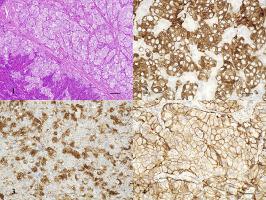Journal of Comparative Pathology ( IF 0.8 ) Pub Date : 2020-11-17 , DOI: 10.1016/j.jcpa.2020.10.001 Cynthia de Vries 1 , Björn Konukiewitz 2 , Wilko Weichert 2 , Günter Klöppel 2 , Heike Aupperle-Lellbach 1 , Katja Steiger 2

|
Although canine pancreatic neuroendocrine neoplasms (PanNENs) have been proposed as a model for the counterpart human neoplasms, the type or grade of human PanNEN that they resemble is unclear. PanNENs in animals are classified as adenoma or carcinoma, whereas in humans they are classified as pancreatic neuroendocrine tumour (PanNET) if well-differentiated, or as pancreatic neuroendocrine carcinoma (PanNEC) if poorly differentiated. We evaluated 16 canine primary PanNENs and two metastases histologically and immunohistochemically, and graded them using the animal and human grading systems. All neoplasms had local or vascular invasion and were classified as pancreatic islet cell carcinomas according to the current WHO classification. The Ki-67 index was low in all cases (0.01–1.50%). All had cytoplasmic expression of synaptophysin and insulin but were immunonegative for glucagon, confirming a functional diagnosis of canine insulinoma. Membranous expression of SSTR2A and nuclear expression of ATRX, but no p53 expression, was found in all neoplasms. One primary tumour was diagnosed as a mixed neuroendocrine-non-neuroendocrine neoplasm, which is the first report of this neoplasm in dogs. The other 15 primary tumours and both metastatic tumours were graded as PanNET G1, according to the human WHO classification. We conclude that canine PanNENs share well-differentiated histomorphology, SSTR2A expression and absence of nuclear p53 immunolabelling with human PanNETs G1. However, they differ in ATRX gene expression and functionality, and seem to have a worse prognosis than human PanNETs G1, although their generally low Ki-67 index precludes more precise assessment of prognosis. Membranous SSTR2A expression renders canine PanNENs potentially amenable to treatment with somatostatin analogues or SSTR targeted in-vivo imaging methods.
中文翻译:

犬胰腺神经内分泌肿瘤与人类胰腺神经内分泌肿瘤相似吗?比较形态学和免疫组织化学研究
尽管犬胰腺神经内分泌肿瘤 (PanNEN) 已被提议作为对应人类肿瘤的模型,但它们相似的人类 PanNEN 的类型或等级尚不清楚。动物中的 PanNEN 被归类为腺瘤或癌,而在人类中,如果分化良好,它们被归类为胰腺神经内分泌肿瘤 (PanNET),如果分化较差,则被归类为胰腺神经内分泌癌 (PanNEC)。我们在组织学和免疫组织化学上评估了 16 个犬原发性 PanNEN 和两个转移灶,并使用动物和人类分级系统对它们进行了分级。所有肿瘤都有局部或血管侵犯,根据当前的 WHO 分类被归类为胰岛细胞癌。Ki-67 指数在所有情况下都很低(0.01-1.50%)。所有这些都具有突触素和胰岛素的细胞质表达,但对胰高血糖素呈免疫阴性,证实了犬胰岛素瘤的功能诊断。在所有肿瘤中都发现了 SSTR2A 的膜表达和 ATRX 的核表达,但没有 p53 表达。一个原发肿瘤被诊断为混合性神经内分泌-非神经内分泌肿瘤,这是该肿瘤在犬中的首次报道。根据人类 WHO 分类,其他 15 个原发肿瘤和两个转移性肿瘤都被评为 PanNET G1。我们得出结论,犬 PanNENs 与人类 PanNETs G1 共享良好分化的组织形态学、SSTR2A 表达和核 p53 免疫标记的缺失。然而,它们的不同之处在于 在所有肿瘤中都发现了 SSTR2A 的膜表达和 ATRX 的核表达,但没有 p53 表达。一个原发肿瘤被诊断为混合性神经内分泌-非神经内分泌肿瘤,这是该肿瘤在犬中的首次报道。根据人类 WHO 分类,其他 15 个原发肿瘤和两个转移性肿瘤都被评为 PanNET G1。我们得出结论,犬 PanNENs 与人类 PanNETs G1 共享良好分化的组织形态学、SSTR2A 表达和核 p53 免疫标记的缺失。然而,它们的不同之处在于 在所有肿瘤中都发现了 SSTR2A 的膜表达和 ATRX 的核表达,但没有 p53 表达。一个原发肿瘤被诊断为混合性神经内分泌-非神经内分泌肿瘤,这是该肿瘤在犬中的首次报道。根据人类 WHO 分类,其他 15 个原发肿瘤和两个转移性肿瘤都被评为 PanNET G1。我们得出结论,犬 PanNENs 与人类 PanNETs G1 共享良好分化的组织形态学、SSTR2A 表达和核 p53 免疫标记的缺失。然而,它们的不同之处在于 根据人类世界卫生组织分类。我们得出结论,犬 PanNENs 与人类 PanNETs G1 共享良好分化的组织形态学、SSTR2A 表达和核 p53 免疫标记的缺失。然而,它们的不同之处在于 根据人类世界卫生组织分类。我们得出结论,犬 PanNENs 与人类 PanNETs G1 共享良好分化的组织形态学、SSTR2A 表达和核 p53 免疫标记的缺失。然而,它们的不同之处在于ATRX基因表达和功能,似乎比人类 PanNETs G1 具有更差的预后,尽管它们通常较低的 Ki-67 指数妨碍了对预后的更精确评估。膜性 SSTR2A 表达使犬 PanNENs 可能适合用生长抑素类似物或 SSTR 靶向体内成像方法治疗。











































 京公网安备 11010802027423号
京公网安备 11010802027423号